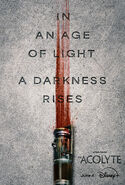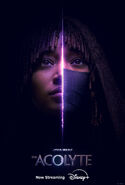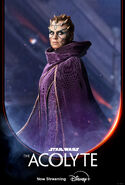- "Leslye Headland, Emmy-nominated creator of the mind-bending series Russian Doll, is a boldly innovative filmmaker bringing her new Star Wars series to Disney+. The Acolyte is a mystery thriller that will take us into a galaxy of shadowy secrets and emerging Dark Side powers in the final days of the High Republic era."
- ―President Kathleen Kennedy announces the series during Disney Investor Day 2020
The Acolyte is a Star Wars television series developed by Leslye Headland for Disney+. Headland wrote, executive produced, and served as the series' showrunner. It takes place a century before the events of Star Wars: Episode I The Phantom Menace, and focuses on the emergence of dark side powers in the final days of the High Republic Era. The Acolyte premiered on June 4, 2024 and concluded on July 16, 2024.
Official description[]
The Acolyte is a mystery-thriller that will take viewers into a galaxy of shadowy secrets and emerging dark-side powers in the final days of the High Republic era. A former Padawan reunites with her Jedi Master to investigate a series of crimes, but the forces they confront are more sinister than they ever anticipated.[5]
Development[]
Conception and announcements[]
- "I think you see more morally ambiguous characters than you've seen in other Star Wars content. And I think I can say this pretty confidently: I don't think you're going to see action in other shows the way that you see it used and utilized in our show. I just thought it was very interesting to do a show about the bad guys and to set that during that period made the most sense, so I think that's what sets it apart. It's kind of almost flipped. We have more Jedi than you've seen in any other of the Star Wars content. I can say this pretty confidently, I don't think you're going to see action in other shows the way that you see it utilized in our show."
- ―Leslye Headland
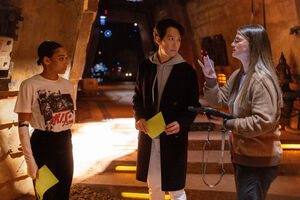
Amandla Stenberg, Lee Jung-jae, and director Leslye Headland
Leslye Headland, having served as co-creator for the 2019 Russian Doll television series, in her words "essentially cold-called Lucasfilm" and pitched what would become The Acolyte as a cross between Disney's 2013 film Frozen and Quentin Tarantino's 2003 film Kill Bill. The series' main characters of Verosha "Osha" Aniseya and Mae-ho "Mae" Aniseya were inspired by Headland's relationship with her youngest sister, and Lucasfilm's President Kathleen Kennedy told Headland to fashion her Star Wars story akin to her "incredibly emotional" play Cult of Love about siblinghood. Kennedy responded to Headland's early scripts in 2019: "You've written a great Star Wars show. Now go write a Leslye Headland show."[13]
On April 22, 2020, Variety reported that Leslye Headland was writing and serving as showrunner for a Star Wars series that would be released on the Disney+ streaming platform. The report noted that the series will be female-centric and take place in a new part of the Star Wars timeline.[14] An official announcement on May 4, 2020 on StarWars.com added that Headland will be an executive producer on the project.[2] The series's title, logo, and general premise were revealed at a Disney investors' meeting on December 10, 2020.[15] Lucasfilm's website also listed vice president of film development Rayne Roberts as co-developing the series with Headland.[16]
Following a conversation between director Kogonada and actress Jodie Turner-Smith at the premiere of their film After Yang at the Cannes Film Festival in July 2021, Kogonada offered Turner-Smith the role of Mother Aniseya.[17] On July 22, 2022, Amandla Stenberg announced alongside the Star Wars account on Instagram that she has been cast in the series.[7] On November 7, 2022, StarWars.com announced that the series began production in the United Kingdom and revealed several additional cast members.[5] In July 2023, Headland gave a statement on the show's tone and characters, promising a morally grey look into the Star Wars universe and unique action.[12]
Inspiration and filming[]
- "She's like an orchestra director. She has an eye on everything very calmly from above, navigating with such kindness and grace. And because she's such a passionate, creative person, she has such love for every single craft on set. She was always so excited and she had so much respect for everyone. And that's really rare."
"I love somebody who's unafraid to live in who they are and their energy unapologetically. Most people in the world are attracted to that kind of freedom." - ―Dafne Keen and Charlie Barnett, on Leslye Headland's direction
Literary and Star Wars influences[]
Leslye Headland drew from storytelling in both the Star Wars Legends continuity, such as its 1990s roleplaying games as part of what was then known as the "Expanded Universe" beyond the stories of Star Wars creator George Lucas, and the ongoing Star Wars: The High Republic multimedia project that was launched by Lucasfilm Publishing in 2021. The concept of an acolyte, after which the series is titled, was taken from the Legends continuity; a Sith Acolyte refers to an individual being trained for the position of a Sith's formal apprentice. Headland included Vernestra Rwoh, who was introduced as a Jedi Padawan learner in Justina Ireland's 2021 novel A Test of Courage, set during the golden age of the Galactic Republic's democracy and the Jedi Order in the High Republic Era in 232 BBY. The Acolyte is set a hundred years afterward and stars Rwoh as a Jedi Master. The series is also set a hundred years before George Lucas' prequel trilogy.[19]
Headland thought about Jedi Masters Mace Windu and Yoda's remarks about the relative dormancy of the dark side of the Force in the 1999 prequel film, Star Wars: Episode I The Phantom Menace, asking who would have been practicing the dark side in the century leading up to the Sith's return and the rise of the Galactic Empire, as shown in 2002's Star Wars: Episode II Attack of the Clones and 2005's Star Wars: Episode III Revenge of the Sith. Headland also compares the time of the High Republic in which The Acolyte is set to the isolationist tendencies of the United States post-World War I, particularly in terms of the decay of the High Republic to the time of the prequel trilogy, when Darth Sidious infiltrated the Galactic Senate.[19]
In terms of spirituality in Star Wars, Headland felt that the concept of the Force as explained by Yoda in The Empire Strikes Back strongly resonated with her, as compared to "even" the English author J.R.R. Tolkien, whose The Lord of the Rings fantasy was published in the 1950s, or her own Catholic upbringing.[19] The fantasy aspect of the galaxy far, far away also prompted her to compare it to the realm of Narnia created by C. S. Lewis, a contemporary of Tolkien's. Headland had a tattoo printed on her right hand after Lucasfilm hired her for The Acolyte, serving as a reminder of Star Wars to herself while making the series—the tattoo shows Ralph McQuarrie's concept illustration of Princess Leia Organa for Lucas' original trilogy, released between 1977 and 1983.[20]
Cinematic influences[]
Hong Kong Chinese martial arts and Japanese samurai cinema[]
Headland also drew inspiration from her favorite martial arts films. The Hong Kong Shaw Brothers Studio film Come Drink with Me—directed by King Hu, set in the Ming era (1368—1644), and released in 1966 under the Chinese title 大醉俠—features a sequence at an inn that forms the basis of the Lomi Usqi Noodle Shop at the opening of The Acolyte's first episode, "Lost / Found."[21] The fight sequence there between Jedi Master Indara and the assassin Mae also pays homage to the martial arts choreography of Crouching Tiger, Hidden Dragon, a 2000 Ang Lee film titled in Chinese as 臥虎藏龍.[22]
Aside from Chinese martial arts films, known as "mouhap" in Cantonese and "wuxia" in Mandarin, Headland was also inspired by the Japanese samurai film Yojimbo, directed by Akira Kurosawa and released under the Japanese title 用心棒 in 1961.[20] She explained that The Mandalorian producer Jon Favreau had mentioned that George Lucas had been influenced by Kurosawa's filmmaking and Western films, and Headland herself based her cinematic influences more strongly on martial arts films such as Shaw Brothers and King Hu productions—naming Come Drink with Me alongside King Hu's 1971 film A Touch of Zen, in Chinese titled 俠女—that are "less global and galactic," with deeply personal missions in which the warriors felt "wronged" and had to "make it right."[19] As a mystery thriller, The Acolyte was influenced by Kurosawa's film Rashomon, released in 1950 under the Japanese title 羅生門, for its use of differing interpretations of the same events.[20] Cinematographer Chris Teague additionally cited the 1973 Toshiya Fujita film Lady Snowblood, a period drama titled 修羅雪姫 in Japanese, as an inspiration for The Acolyte's camerawork.[23]
Character inspirations[]
Headland compared the story of Mae to Frozen and Kill Bill, and the character was also inspired by the story of Ahsoka Tano in the Star Wars: The Clone Wars television series' 2013 episode "The Wrong Jedi" and the dynamic between Qi'ra and Maul at the end of the 2016 film Solo: A Star Wars Story.[24] Amandla Stenberg wrote about the motivations and inner lives of Osha and Mae,[17] with separate binders for each twin to inform her approach as a performer and differentiating the characters.[25] Indara was inspired by the character Trinity from the Wachowskis' The Matrix film franchise (1999—2021), played by Carrie-Anne Moss, who Headland also cast as Master Indara.[26] For the first episode, "Lost / Found," Headland described the character's demeanor as both relaxed and controlled; a mix of Lucas' Skywalker saga Jedi character Obi-Wan Kenobi and the character O-Ren Ishii from Kill Bill.[27]
Mae's accomplice, Qimir, is played by Manny Jacinto as a scoundrel archetype based on Johnny Depp's performance of Jack Sparrow in the Pirates of the Caribbean film series (2003–2017). Jacinto also compared Qimir's movements to the silent film works by Buster Keaton and Charlie Chaplin in the early 20th century.[28] Jacinto appreciated the duality of his character as a dream role for an actor, being able to emphasize the comic qualities of Qimir and then the stillness of the Stranger.[29]
The fourth and fifth episodes, respectively titled "Day" and "Night," were partly inspired by two Hollywood science fiction films: Ridley Scott's 1979 Alien and John McTiernan's 1987 Predator.[30] Given his dual role as the Stranger, Jacinto was additionally inspired by Toshiro Mifune's performance as the warrior Kikushiyo in 1954's Seven Samurai, a Kurosawa film named 七人の侍 in Japanese, and Jackie Chan's performance as the martial artist Wong Fei-hung in the Hong Kong film Drunken Master, released as 醉拳 in 1978.[31]
Production design[]
- "If you look at periods of extended peace in history, you have things like the Renaissance, where art, design, architecture, and clothing are allowed to flourish because the money, resources, and creativity are available to make beautiful things. So, that was part of the design ethos that Kevin took onboard, as well as the costume design. The costumes, the lightsabers, even to some extent the ships, feel less brutal and more designed and finessed. The Jedi's robes have more gold and are more regal. There are more curves and flowing lines in the ships."
- ―Visual effects supervisor Julian Foddy
Brendok's mountain retreat was inspired by the 1947 British film Black Narcissus by Michael Powell and Emeric Pressburger—set at a nuns' mountain retreat in the Indian Himalayas—coupled with the Hoover Dam in the United States.[23] For Coruscant and its Jedi Temple, production designer Kevin Jenkins and visual effects supervisor Julian Foddy decided aligning moreso with the prequel trilogy's establishing shots than the ground-level perspective shown in the 2022 television series Andor, but with distinctive aesthetics echoing the 1971 William Friedkin film The French Connection and 1970s New York City: in particular, a desaturated and photorealistic "retro" atmosphere of haziness.[33]
Jenkins heeded George Lucas' 1977 film Star Wars: Episode IV A New Hope's lived-in aesthetic, stating that the core of Star Wars is Stanley Kubrick's 1968 film 2001: A Space Odyssey "with dirt"—he learned from the designs of A New Hope production crew John Barry, Norman Reynolds, and Ralph McQuarrie while cinematographer Chris Teague used anamorphic lenses for The Acolyte, with film grain being added to the footage. Jenkins also likened Headland's episodic structure to the cliffhanger-based approach of the Flash Gordon serials, and further compared the High Republic Era to the height of the Roman Empire, incorporating vivid colors in The Acolyte's production design while maintaining a uniformity of Jedi designs previously shown in The High Republic publishing initiative.[23] Jenkins said Olega's city was "essentially Casablanca in space" with its blue and red color palette,[34] while StarWars.com stated it was inspired by Marrakesh, another city in Morocco.[35]
Costume designer Jennifer Bryan researched Trisha Biggar's prequel trilogy costumes at the Lucasfilm Archives at Skywalker Ranch, which particularly informed the clothing of the High Republic Era Jedi along with existing designs, such as High Republic Jedi symbols, from the multimedia project. The color palette of Osha's civilian clothing was informed by the era of the Vietnam War that preceded George Lucas' original trilogy and the Star Wars design principle of greeblies and badges. Another distinctive Star Wars fashion staple, the poncho, was also incorporated in civilian clothing featured in later episodes. Bryan further took inspiration from warrior cultures from Asia Minor, East Africa, North Africa, and the Roman and Byzantine Empires: "It needs to look like it's put together from these different historical eras of warriors, but not specific to any one culture." Mae's assassin attire in particular was informed by samurai elements. Bryan also thought that Jodie Turner-Smith's elegance complemented the design made for Mother Aniseya, while Yord Fandar's fastidiousness and "lustrous drape" called for fabrics slightly different from those used on other Jedi costumes, with his more appearance-conscious attitude reflected in a cloak informed by Roman senators' togas.[36]
The production gave special thanks to the historic Lucasfilm Archives at Skywalker Ranch and George Lucas' new Lucas Museum of Narrative Art.[9] Leslye Headland emphasized using practical techniques in her direction of the production design, cinematography, and visual effects.[33]
Filming in Madeira, Wales, and England[]
- "What was really interesting about Wales, especially Southern Wales, is that it had a very raw sort of feeling to it. What also gravitated us to the area was the location of the landing of the [Jedi starship] Polan, which became our anchor base. Just behind us in that same valley was this old 18th century dam, this massive black stone brick wall. And nearby was this wonderful forest where the whole floor was a bed of moss growing up the trees that I thought could be where the girls are first introduced. So with the moss forest, the valley vistas and this dam that's singing out to be used, Wales just seemed to tick all the boxes."
- ―Kevin Jenkins
Filming began in Europe's autumn in 2022 and lasted until May of 2023.[33] Filming was largely done on location on Portugal's Madeira archipelago off the coast of Africa and in and around the mountainous forest of the Bannau Brycheiniog National Park (Brecon Beacons) in Wales. Interior scenes were shot at Shinfield Studios in Berkshire, England.[34] Shooting also took place at the woods of Berkshire's Englefield Estate.[37] Manny Jacinto prepared for his role as Qimir in the relative seclusion of the nearby town of Windsor.[31] Sur Film provided production services in Portugal.[9]
The crew initially used Madeira for the planet Khofar's jungles, but they made use of other parts of the archipelago for scenes set on the unknown Sith planet, Olega, and Ueda as well.[23] Khofar's forest perimeter was shot at Pico do Arieiro and digitally inserted to shots of the Fanal Forest and Poço das Casas. The interior of the jungles was filmed at Shinfield Studios, with practical "mega trees" occupying the soundstage and even some of its stage doors. A short scene of Ueda was shot at Ponta de São Lourenço for its "brown, dusty Western" aesthetic, and the establishing shot of Olega was shot at Pedra D'Eira. Olega's city scenes were shot in Shinfield Studios. The exterior island shots of the "unknown planet" were captured along the northern coastline of western Madeira, and the mouth of Stranger's cave is located at Ribeira de Janela. "Fifteen minutes down the road," the crew found the Porto Moniz Rockpools and shot the Stranger's bathing scene there.[34]
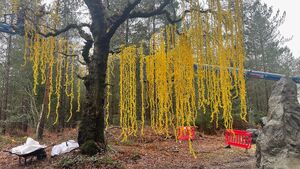
A dead oak tree in southern Wales is dressed in yellow willow-like branches.
An empty lot and several fields near the Trago Mills department store in Merthyr Tydfil were used for The Acolyte's production in Wales.[38] The series introduces the planet Brendok, with all of its exterior scenes being shot in Southern Wales—aside from the campfire scene, shot at England's Pinewood Studios in Iver Heath, Buckinghamshire. The crew filmed in the mossy Taf Fechan forest, a dead oak tree in the Cadlan Woods that was decorated for the yellow willow-like bunta tree, and the drained Upper Neuadd Reservoir of Bannau Brycheiniog. The Upper Neuadd Dam served as the exterior of the Brendok witch coven's mountain retreat. The dam informed the design of the retreat, and its interior scenes were shot at Shinfield Studios.[34]
The series was shot with cameras and ARRI ALFA lenses supplied by ARRI Rental.[9]
Post-production in London, Canada, India, Austria, Australia, and California[]
- "The musical themes in The Acolyte are tied more to an emotion or a point of view or a literary theme than they are to a particular character."
- ―Composer Michael Abels
The series was edited by Miikka Leskinen and Cheryl Potter with Avid editing equipment supplied by HireWorks. Sound services were provided by Skywalker Sound in Marin County, California, with Brian Chumney as the supervising sound editor.[9] Visual effects post-production was led by Industrial Light & Magic (ILM), a Lucasfilm subsidiary, with its studios in London, England, and Vancouver, Canada, extending through to the late end of winter in 2024. ILM's new office in Mumbai, India, also contributed to the nearly 3000 shots made for The Acolyte, marking one of its first completed works.[33] Additional visual effects were made by Yannix and SDFX Studios,[9] as well as the London-based Outpost Visual Effects and the Vancouver-based beloFX.[33] Visual effects were also partly produced in Melbourne, Australia,[9] with Rising Sun Pictures of nearby Adelaide and the Los Angeles–based Luma Pictures having contributed too,[33] as did Hybride of Ubisoft[9] in Montreal, Canada.[33] Proof Inc. additionally provided visualization services.[9]
Unlike previous productions centered at ILM's headquarters in San Francisco, California, ILM London served as the visual effects post-production hub for The Acolyte, led by production supervisor Julian Foddy. The visual effects crew worked closely with the creatures' department led by Neal Scanlan and editors Leskinen and Potter for the hybrid practical effects and computer graphics shots of the umbramoths.[32]
The score of The Acolyte was composed by Michael Abels with additional music by Miguel Bezanilla, Cameron Moody, and Robert Wallace. The score was recorded at Synchron Stage Vienna in Austria under the conductor Gottfried Rabl.[9] Abels pointed out that the musical themes were emotion-based rather than character-based, taking the example of the "duality of the characters" Mae and Osha when they are vengeful or hopeful, with the same musical motifs occurring with different characters. Abels added that "You can tell I've had a lot of fun playing with how the Force is used and who uses it and what we think about whether that use of the Force is good or bad." While the score does not foreshadow or connect the music associated with Qimir with the Stranger, when the Stranger is revealed at the end of "Day," the music includes a nod to Kylo Ren's theme. In keeping with the cinematic echo with Rashomon, the two flashback episodes include scenes in which the visuals are the same yet the music is different to accentuate different emotional perspectives.[39]
Production finance[]
- "The Acolyte had many strong reviews and did well in the ratings its first week out, but you ultimately opted against a second season. Why didn't you move forward? And can you offer any hint as to how Skeleton Crew is doing, or its future?"
"So as it relates to Acolyte, we were happy with our performance, but it wasn't where we needed it to be given the cost structure of that title, quite frankly, to go and make a season two. So that's the reason why we didn't do that. Skeleton Crew is in process now, so we'll see. We've seen some growth on that. We’ll see how that goes. As you said, the reviews have been excellent on Skeleton Crew, so we'll have to see how that all plays out as it moves forward." - ―Interviewer Josef Adalian for Vulture and Alan Bergman, co-chair of Disney Entertainment
The Acolyte was produced with the support of the British Film Commission and the UK Government's High-End Television Tax Relief, the Canadian Film or Video Production Services Tax Credit, the Province of British Columbia Production Service Tax Credit, Québec's Production Services Tax Credit, Portugal's Tourism and Cinema Fund, and the Australian Government's PDV Offset tax rebate. Visual effects production in Australia was also supported by VicScreen in Victoria and in South Australia with the support of the South Australian Film Corporation.[9]
While media outlets reported that the series' production cost was around $180 million in US dollars,[13] Lucasfilm had registered a subsidiary high-end television program production company in England and Wales named Blue Stockings (UK). The company's publicly filed audit covering March 24, 2021 to September 24 2023, reports that "the cost was forecasted to be over the production budget" but are approved and fully funded by Lucasfilm as of September 24, 2024, with the production having been certified by the British Film Institute in the interim as "British,"[41] which would qualify the production for HM Revenue and Customs tax credits[42] for the ultimate parent company, The Walt Disney Company. The report further indicates that UK television production expenditure between those dates totalled £172,320,864 in British pound sterling, equivalent to around $230 million US dollars. Based on the UK tax relief scheme, the same filing claims a total of £34,839,012 pounds of expenditure credits for the relevant periods—which would bring Blue Stockings' production cost down to £137,481,852 pounds, equivalent to just under $184 million US dollars.[41]
Release and reception[]
- "She put so much care and thought and love into that, and it's disappointing to feel like your studio is not having your back in a very public-facing way. They've got to stop doing this thing where they don't say anything when people are getting fucking dog-piled on the internet with racism and bullshit. It's just not fair to not say anything. It's really unfair. It would just be nice if the people that have all the money were showing their support and putting their feet down, say this is unacceptable: 'You're not a fan if you do this.' Make a really big statement and just see if any money leaves. I bet you it won't, because people of colour, and especially Black people, make up a very large percentage of buying power. They might find that it's actually more lucrative for them, but everyone's using 'woke' like it's a dirty word. Opinions change. What's in vogue changes. We're gonna get there at some point, to that place where people stop having a stick up their arse about people of colour being a part of IPs that were created by white people. You know why? Because we're never going to fucking stop participating."
- ―Jodie Turner-Smith, criticizing Disney and Lucasfilm's passivity to targeted harassment of Amandla Stenberg

Amandla Stenberg
In 2024, Lucasfilm released the series' teaser trailer online on March 18,[6] prior to releasing the final trailer on May 4 online[43] and in theaters.[13] Later on the 20th of that month, Lucasfilm Online released a video of Amandla Stenberg playing a new Star Wars violin arrangement of "The Force Theme" that composer John Williams had written specifically for her,[44] with Stenberg proudly performing on her grandfather's violin.[25] Consisting of eight episodes, The Acolyte's first two episodes premiered several days later on Disney+ on June 4, and the final episode was released on July 16.[13]
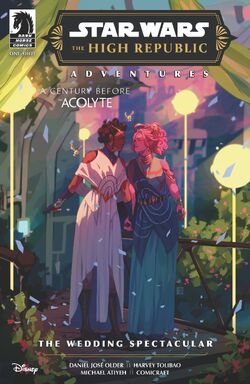
A comic featuring the text "a century before The Acolyte"
Novels and comics of The High Republic have been marketed in relation to the series, with text such as "a century before The Acolyte" featuring on their covers.[45] BioWare's video game Star Wars: The Old Republic, which has been running since 2011 as part of the Star Wars Legends continuity, was updated with player armor in the style of "The Stranger" and an appearance option in the style of Osha and Mae Aniseya[46] in collaboration with Lucasfilm Games.[47] Following The Acolyte's season finale, the official Star Wars books Twitter page urged fans interested in the High Republic Era thanks to the series to check out the time period's multi-media project, beginning with author Charles Soule's novel The High Republic: Light of the Jedi.[48]
Racist and sexist online harassment targeted The Acolyte's cast members[49] and review-bombed the series on ranking websites.[50] On June 19, the date of "Juneteenth" commemorations of the end of slavery in the United States, Amandla Stenberg posted a music video on Instagram addressing the tired bigotry of discourse around The Acolyte. She criticized the transformation of the term "woke" for culture war and clickbait purposes, including journalists who sacrifice "truth" for selective "metrics and data" that fuel division. Co-stars Charlie Barnett, Manny Jacinto, and Dafne Keen commented in support of Stenberg.[51]
On August 19, 2024, Deadline first reported that the show had been "canceled" and would not have a second season,[52] and Gizmodo published an updated report that Lucasfilm confirmed to the media outlet that there would not be a second season of The Acolyte and that it "had never been officially greenlit."[53] Twitter owner Elon Musk later reacted to the news on the social media platform to suggest that the series is "woke."[49] The Acolyte writer Jen Richards criticized the Hollywood industry on Twitter on August 20 for its aversion to "risk" and studio monopolies that only care about immediate financial profits for shareholders rather than art and culture. John Boyega, who had played Finn in the sequel trilogy and faced racist abuse for his role, acknowledged Amandla Stenberg on an old Instagram post of hers on August 21 amidst a flurry of hateful comments.[54] In an article titled "Can the Best of Star Wars Survive the Worst of Its Fans?" on August 23, the Rolling Stone reported that neither Lucasfilm nor Disney representatives have responded to their requests for comment on the series' discontinuation.[49] On the same day, Entertainment Weekly reported that Lee Jung-jae was "surprised" by the news and hoped that Disney would invite showrunner Leslye Headland to make a second season of The Acolyte,[55] and via Instagram's story feature, Rebecca Henderson reposted both the aforementioned Rolling Stone article and a fan's tweet calling on "Disney" not to cater to a certain "part of the Star Wars fanbase."[50] Manny Jacinto simply posted one of The Acolyte's closing shots featuring himself as "the Stranger" and Amandla Stenberg as Osha Aniseya with a red heart emoji on Instagram.[54] Joonas Suotamo likewise posted an image of himself as Kelnacca with a red heart emoji on Instagram on August 24.[56]

Amandla Stenberg performing the violin solo written for her by John Williams
On August 28, Stenberg spoke about The Acolyte's cancelation via Instagram stories. The artist said it was "not a huge shock" for them given the "hyper-conservative bigotry and vitriol, prejudice, hatred, and hateful language" with which "the alt-right" targeted the series' creators such as herself—starting when the series was just announced in 2020 through the announcement of Stenberg's casting in 2022 to the series' release in 2024—though she also thanked "everybody who watched it" and appreciated the fans' support, artwork, and theories. They also spoke about how part of processing the vitriol meant being personally vocal in line with her own values despite working under Disney, and called her role in Star Wars "an incredible honor and dream" and gave high praise to Lucasfilm, the "vision" of producer Rayne Roberts, and showrunner Leslye Headland: "I will love this experience with her forever." As for the fans, Stenberg wanted to say that they are "deeply loved and appreciated, and it made this job all the worthwhile." Stenberg lastly expressed that "we all exist in the context in all which we live," calling on people to vote in the 2024 United States elections and also referring to the "hyper divisiveness" of internet discourse around Star Wars that they found has been "driven by echo chambers of thought and algorithms that reinforce our biases," and she wanted to "challenge us all and challenge myself to continue questioning what it is that I digest and think critically about what shapes it."[57] On August 29, Ahmed Best, who had faced vicious abuse for his role as Jar Jar Binks in the prequel trilogy, posted in solidarity with Amandla Stenberg on Instagram.[58]
On October 2, in an interview with Glamour magazine for its Women of the Year Awards, Jodie Turner-Smith praised Amandla Stenberg's dedication to her role and criticized the movie studios for being unsupportive of the actor even while racist abuse runs rampant online. Turner-Smith believed that making a statement against racist abuse would not incur damage to corporate revenue given that people of color, particularly Black people, "make up a very large percentage of buying power." She added that opinions and trends attacking people of color for taking part in intellectual properties started by white people, such as Star Wars, would eventually pass even though people such as herself "don't get to fail upwards like a lot of white men."[17] In an interview with Vanity Fair later in November, Lee Jung-jae said that he felt "hurt" and was especially sorry for Leslye Headland by the racist reactions to The Acolyte, though he added that he has faith for racism to eventually end. Lee also expressed gratitude for the support of fans and had "strong hopes" for audiences to better appreciate the series as time goes by.[59] On December 19, 2024, in an interview with Josef Adalian for the Vulture news website, Alan Bergman, co-chair of Disney Entertainment, acknowledged in reply to a question about both The Acolyte and the Star Wars: Skeleton Crew television series that premiered earlier that month that The Acolyte was not renewed for a second season. Despite both series receiving good reviews, Bergman blamed "the cost structure" of The Acolyte even though "we were happy with our performance."[40]
Episodes[]
| Episode | Image | Title | Original Airdate | Prod. # |
|---|---|---|---|---|
| 1 |  |
"Lost / Found" | 1-1[1] | |
| 2 |  |
"Revenge / Justice" | 1-2[1] | |
| 3 |  |
"Destiny" | June 11, 2024[60] | 1-3[1] |
| 4 |  |
"Day" | June 18, 2024[60] | 1-4[1] |
| 5 |  |
"Night" | June 25, 2024[60] | 1-5[1] |
| 6 |  |
"Teach / Corrupt" | July 2, 2024[61] | 1-6[1] |
| 7 |  |
"Choice" | July 9, 2024[61] | 1-7[1] |
| 8 |  |
"The Acolyte" | July 16, 2024[62] | 1-8[1] |





